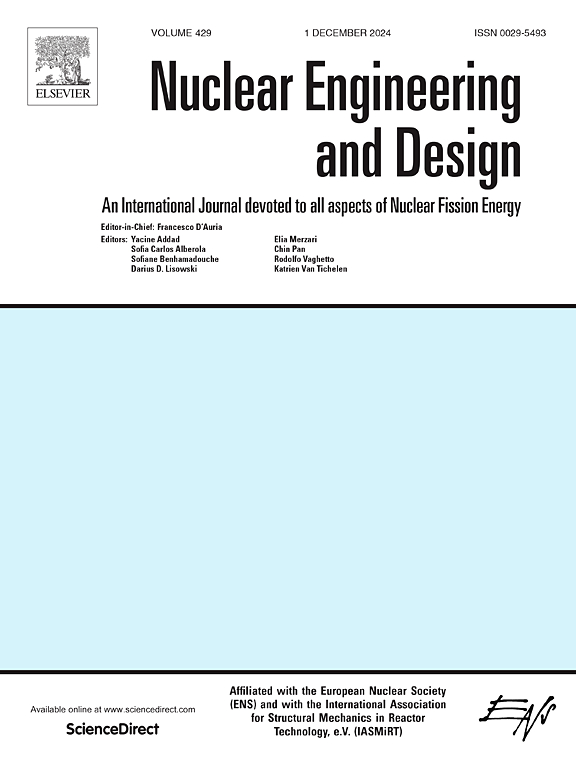SEMRA代码冲击传播模块的验证与验证
IF 2.1
3区 工程技术
Q1 NUCLEAR SCIENCE & TECHNOLOGY
引用次数: 0
摘要
北欧沸水堆(BWRs)的舱前严重事故(SA)缓解策略依赖于干井注水。在反应堆下压头失效的情况下,堆芯被释放到干井的水池中。堆芯喷射料将破碎、淬火,并形成可冷却的碎片床,最终防止安全壳失效和放射性产物释放到环境中。当堆芯在水中破碎时,在熔体周围形成一层蒸汽膜,防止熔体与水直接接触,并限制了两种液体之间的热传递。在汽膜崩溃的情况下,熔体的热能可能会被触发为蒸发挥发性冷却剂的机械能的爆炸性转换。这些现象通常被称为蒸汽爆炸(SE)。由此产生的压力波可能通过水-堆芯混合物传播,升级并形成冲击波,有可能挑战安全壳的完整性。蒸汽爆炸具有重要的现象学和情景不确定性。由于蒸汽爆炸现象的混沌性和缺乏基于稳定性和准确性提高的现代数值方法的蒸汽爆炸模拟规范,进一步加剧了风险分析中的不确定性量化问题。这项工作的目标是开发一个数字代码SEMRA(蒸汽爆炸建模和风险分析),用于模拟熔体-冷却剂相互作用和评估由于蒸汽爆炸导致的安全壳失效的风险。在本文中,我们的重点是开发的确定性部分的代码,利用改进的数值方法来评估蒸汽爆炸的传播。目的是验证压力传播的实施数值方案,并为下一阶段的代码开发建立一个参考解决方案,该方案包含更全面的热力学建模和与蒸汽爆炸相关的传输现象。具体来说,我们讨论了激波的触发和传播现象。我们使用AUSM+ up、Godunov和HLLC格式实现了一个数值稳定的代码来模拟多相流。我们根据几个已知的验证和确认问题来评估SEMRA代码的性能。然后,我们使用SEMRA代码来模拟在KROTOS设备上进行的触发测试,并将结果与实验结果和TEXAS-V代码计算结果进行比较。分析了通量重建法、消相处理和空间离散化对结果的影响。我们讨论了这些结果及其对增强SE代码中的触发和传播建模的贡献。本文章由计算机程序翻译,如有差异,请以英文原文为准。
Verification and validation of SEMRA code shock propagation module
The ex-vessel severe accident (SA) mitigation strategy in Nordic Boiling Water Reactors (BWRs) relies on drywell flooding. In the event of the reactor lower head failure corium is released into the water pool in the drywell. The corium jet is expected to fragment, quench, and form a coolable debris bed, ultimately preventing containment failure and release of radioactive products into the environment.
During corium fragmentation in water, a vapor film is formed around the melt preventing direct melt-water contact and limiting the heat transfer between the two liquids. In case of vapor film collapse an explosive conversion of thermal energy of the melt into the mechanical energy of the evaporating volatile coolant may be triggered. These phenomena are often called steam explosion (SE). The resulting pressure wave may propagate through the water-corium mixture, escalate and form a shock wave with the potential to challenge containment integrity. There are significant phenomenological and scenario uncertainties associated with steam explosion. The problem of the uncertainty quantification in the risk analysis is exacerbated further by (i) the chaotic nature of the steam explosion phenomena and (ii) the lack of steam explosion modelling codes based on the modern numerical methods with increased stability and accuracy.
The goal of this work is to develop a numerical code SEMRA (Steam Explosion Modelling and Risk Analysis) for modelling of melt-coolant interactions and assessment of the risk of containment failure due to steam explosion. In this paper, we focus on the development of the deterministic part of the code that utilizes improved numerical methods to assess the propagation of steam explosions. The objective is to verify the implemented numerical schemes for pressure propagation and to establish a reference solution for the next stage of code development which incorporates more comprehensive thermodynamic modelling and transport phenomena relevant to steam explosion.
Specifically, we address the phenomena shock wave triggering and propagation. We implement a numerically stable code using AUSM+ -up, Godunov and HLLC schemes to model multiphase flow. We evaluate the performance of SEMRA code against several known verification and validation problems. Then we use SEMRA code to simulate triggering tests carried out in KROTOS facility and compare the results against the experiment and TEXAS-V code calculations. We analyze the effect of the flux reconstruction method, the vanishing phase treatment and the spatial discretization on the results. We discuss the results and their contribution to the enhancement of triggering and propagation modelling in a SE code.
求助全文
通过发布文献求助,成功后即可免费获取论文全文。
去求助
来源期刊

Nuclear Engineering and Design
工程技术-核科学技术
CiteScore
3.40
自引率
11.80%
发文量
377
审稿时长
5 months
期刊介绍:
Nuclear Engineering and Design covers the wide range of disciplines involved in the engineering, design, safety and construction of nuclear fission reactors. The Editors welcome papers both on applied and innovative aspects and developments in nuclear science and technology.
Fundamentals of Reactor Design include:
• Thermal-Hydraulics and Core Physics
• Safety Analysis, Risk Assessment (PSA)
• Structural and Mechanical Engineering
• Materials Science
• Fuel Behavior and Design
• Structural Plant Design
• Engineering of Reactor Components
• Experiments
Aspects beyond fundamentals of Reactor Design covered:
• Accident Mitigation Measures
• Reactor Control Systems
• Licensing Issues
• Safeguard Engineering
• Economy of Plants
• Reprocessing / Waste Disposal
• Applications of Nuclear Energy
• Maintenance
• Decommissioning
Papers on new reactor ideas and developments (Generation IV reactors) such as inherently safe modular HTRs, High Performance LWRs/HWRs and LMFBs/GFR will be considered; Actinide Burners, Accelerator Driven Systems, Energy Amplifiers and other special designs of power and research reactors and their applications are also encouraged.
 求助内容:
求助内容: 应助结果提醒方式:
应助结果提醒方式:


